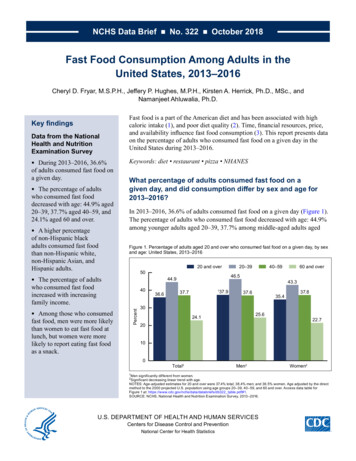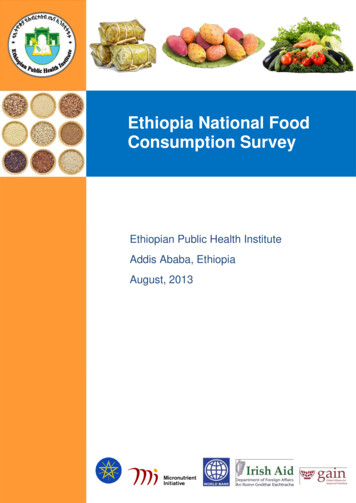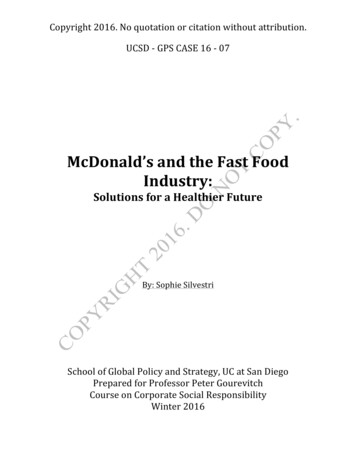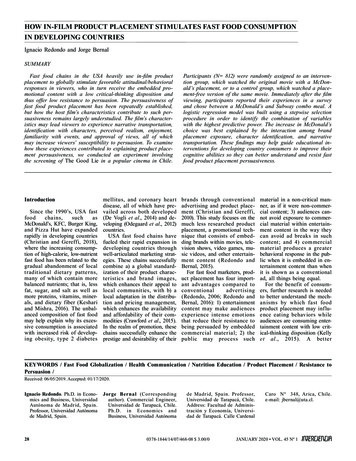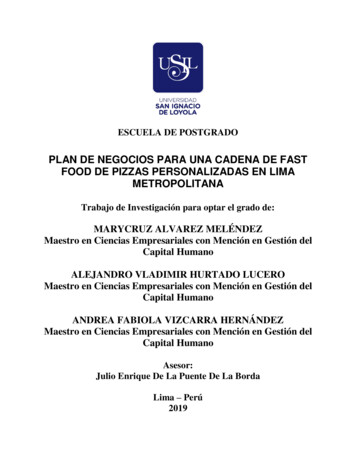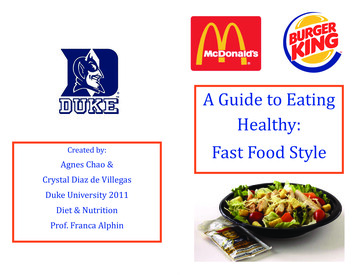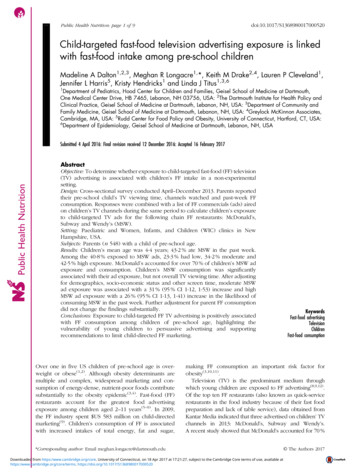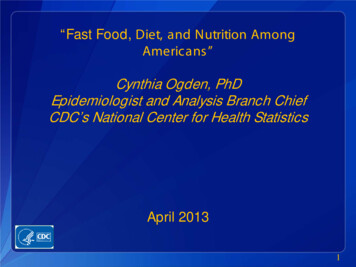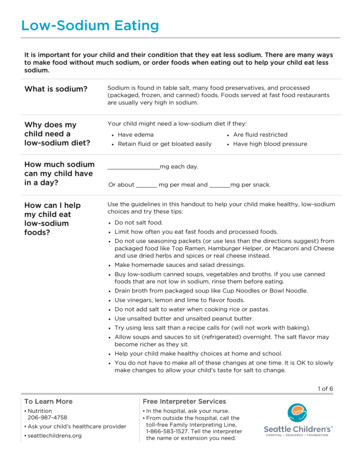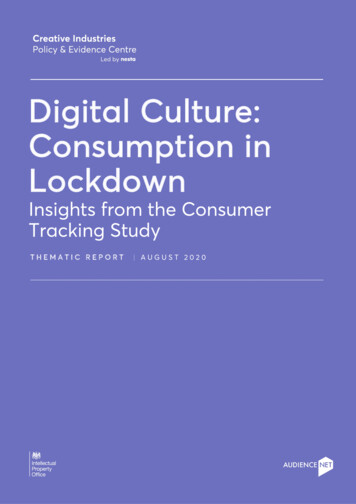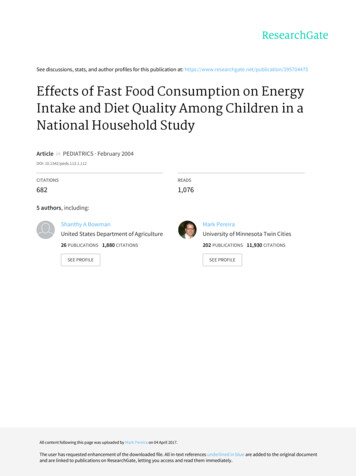
Transcription
See discussions, stats, and author profiles for this publication at: Effects of Fast Food Consumption on EnergyIntake and Diet Quality Among Children in aNational Household StudyArticle in PEDIATRICS · February 2004DOI: 10.1542/peds.113.1.112CITATIONSREADS6821,0765 authors, including:Shanthy A BowmanMark PereiraUnited States Department of AgricultureUniversity of Minnesota Twin Cities26 PUBLICATIONS 1,880 CITATIONS202 PUBLICATIONS 11,930 CITATIONSSEE PROFILESEE PROFILEAll content following this page was uploaded by Mark Pereira on 04 April 2017.The user has requested enhancement of the downloaded file. All in-text references underlined in blue are added to the original documentand are linked to publications on ResearchGate, letting you access and read them immediately.
Effects of Fast-Food Consumption on Energy Intake and Diet Quality AmongChildren in a National Household SurveyShanthy A. Bowman, Steven L. Gortmaker, Cara B. Ebbeling, Mark A. Pereira andDavid S. LudwigPediatrics 2004;113;112-118DOI: 10.1542/peds.113.1.112The online version of this article, along with updated information and services, islocated on the World Wide Web 1/112PEDIATRICS is the official journal of the American Academy of Pediatrics. A monthlypublication, it has been published continuously since 1948. PEDIATRICS is owned, published,and trademarked by the American Academy of Pediatrics, 141 Northwest Point Boulevard, ElkGrove Village, Illinois, 60007. Copyright 2004 by the American Academy of Pediatrics. Allrights reserved. Print ISSN: 0031-4005. Online ISSN: 1098-4275.Downloaded from www.pediatrics.org by on February 4, 2009
Effects of Fast-Food Consumption on Energy Intake and Diet QualityAmong Children in a National Household SurveyShanthy A. Bowman, PhD*; Steven L. Gortmaker, PhD‡; Cara B. Ebbeling, PhD§; Mark A. Pereira, PhD§;and David S. Ludwig, MD, PhD§ABSTRACT. Background. Fast food has become aprominent feature of the diet of children in the UnitedStates and, increasingly, throughout the world. However,few studies have examined the effects of fast-food consumption on any nutrition or health-related outcome.The aim of this study was to test the hypothesis thatfast-food consumption adversely affects dietary factorslinked to obesity risk.Methods. This study included 6212 children and adolescents 4 to 19 years old in the United States participating in the nationally representative Continuing Survey of Food Intake by Individuals conducted from 1994to 1996 and the Supplemental Children’s Survey conducted in 1998. We examined the associations betweenfast-food consumption and measures of dietary qualityusing between-subject comparisons involving the wholecohort and within-subject comparisons involving 2080individuals who ate fast food on one but not both surveydays.Results. On a typical day, 30.3% of the total samplereported consuming fast food. Fast-food consumptionwas highly prevalent in both genders, all racial/ethnicgroups, and all regions of the country. Controlling forsocioeconomic and demographic variables, increasedfast-food consumption was independently associatedwith male gender, older age, higher household incomes,non-Hispanic black race/ethnicity, and residing in theSouth. Children who ate fast food, compared with thosewho did not, consumed more total energy (187 kcal; 95%confidence interval [CI]: 109 –265), more energy per gramof food (0.29 kcal/g; 95% CI: 0.25– 0.33), more total fat (9 g;95% CI: 5.0 –13.0), more total carbohydrate (24 g; 95% CI:12.6 –35.4), more added sugars (26 g; 95% CI: 18.2–34.6),more sugar-sweetened beverages (228 g; 95% CI: 184 –272), less fiber (ⴚ1.1 g; 95% CI: ⴚ1.8 to ⴚ0.4), less milk(ⴚ65 g; 95% CI: ⴚ95 to ⴚ30), and fewer fruits and nonstarchy vegetables (ⴚ45 g; 95% CI: -58.6 to ⴚ31.4). Verysimilar results were observed by using within-subjectanalyses in which subjects served as their own controls:that is, children ate more total energy and had poorer dietquality on days with, compared with without, fast food.From the *US Department of Agriculture, Agricultural Research Service,Beltsville, Maryland; ‡Department of Society, Human Development, andHealth, Harvard School of Public Health, Boston, Massachusetts; and §Department of Medicine, Children’s Hospital, and Department of Pediatrics,Harvard Medical School, Boston, Massachusetts.Received for publication Jul 10, 2003; accepted Aug 7, 2003.Reprint requests to (D.S.L.) Department of Medicine, Children’s Hospital,300 Longwood Ave, Boston, MA 02115. E-mail: david.ludwig@childrens.harvard.eduThis work is solely the responsibility of the authors and does not representofficial views of the Centers for Disease Control and Prevention.PEDIATRICS (ISSN 0031 4005). Copyright 2004 by the American Academy of Pediatrics.112Conclusion. Consumption of fast food among children in the United States seems to have an adverse effecton dietary quality in ways that plausibly could increaserisk for obesity. Pediatrics 2004;113:112–118; fast food,obesity, dietary composition, diet quality, energy intake.ABBREVIATIONS. CSFII, US Department of Agriculture’s Continuing Survey of Food Intakes by Individuals; BMI, body massindex; MSA, metropolitan statistical area.From its origins in the 1950s, fast food has growninto a dominant dietary pattern among childrenin the United States today.1,2 Consumption offast food by children increased a remarkable fivefoldfrom 2% of total energy in the late 1970s to 10% oftotal energy in the mid-1990s.3 The number of fastfood restaurants more than doubled from 1972 to1995 and now totals an estimated 247 115 nationwide.4 Fast food pervades virtually all segments ofsociety including local communities, public schools,and hospitals.5–7 These trends seem to have beendriven by massive advertising and marketing campaigns aimed at children and their parents.2Several dietary factors inherent to fast food maycause excessive weight gain such as massive portionsize, high energy density, palatability (appealing toprimordial taste preferences for fats, sugar, and salt),high content of saturated and trans fat, high glycemicload, and low content of fiber.8 However, few studieshave examined the effects of fast-food consumptionin children.9 –11 In the absence of such data, professional nutritional agencies in the United States12presently support industry claims that fast food canbe part of a healthful diet.13,14The aims of this study were first to examine national patterns of fast-food consumption among children and second to determine whether fast foodadversely affects diet quality in ways that mightplausibly increase risk for obesity.METHODSSubjectsData from the US Department of Agriculture’s ContinuingSurvey of Food Intakes by Individuals (CSFII) 1994 to 1996 and theSupplemental Children’s Survey conducted in 1998 were used forthe study.15 The 1998 sample involved only children from birththrough 9 years old, and the 1994 to 1996 sample involved personsof all ages. These surveys, conducted by the US Department ofAgriculture as part of its ongoing national nutrition-monitoringactivities, are nationally representative and include all 50 statesand Washington, DC. For between-subject comparisons, childrenwho had complete food-intake recalls on the first day of thePEDIATRICS Vol. 113 No. 1 January 2004Downloaded from www.pediatrics.org by on February 4, 2009
survey were categorized into 3 age groups: 4 to 8 years old, 9 to 13years old, and 14 to 19 years old. Within-subject comparisonsincluded children 4 to 19 years old with complete food-intakerecalls on both nonconsecutive days of the survey who had fastfood on one but not both survey days.DesignIn these nationally representative household population surveys, the primary hypothesis was that subjects who consumedfood obtained at fast-food restaurants, compared with those whodid not, would exhibit higher total energy intake and poorer dietquality over the day studied. Multiple regression was used tocontrol for potentially confounding demographic, socioeconomic,and anthropometric covariates. We also conducted within-subjectcomparisons on a subset of individuals who were discordant infast-food consumption on the 2 survey days, because such modelscontrol for between-subject confounding variables.Assessment of Diet and Other VariablesCSFII 1994 to 1996 and CSFII 1998 collected dietary intake dataon 2 nonconsecutive days, 3 to 10 days apart. For between-subjectcomparisons, we used data from the first survey day because ofthe higher overall response rate (for all participants includingchildren and adults, the response rate in CSFII 1994 to 1996 was80.0% on day 1 compared with 76.1% on day 2; and in CSFII 1998,the response rate was 85.6% on day 1 compared with 81.7% on day2). Dietary data were obtained through an interviewer-administered 24-hour recall by using a multiple-pass technique to reduceunder-reporting. Survey instruments were tested in a pilot study,and, based on the study results, the instruments were revisedappropriately. Food coders, field supervisors, and interviewerswere trained before the survey.16 Measuring guides were used tohelp respondents estimate the amount of food and beveragesconsumed. Spanish-language questionnaires were used when appropriate. The accuracy and utility of translations were checkedbefore the survey. If a sampled person spoke neither English norSpanish, a family member or neighbor ⱖ16 years old served as aninterpreter.In the surveys, children ⱖ12 years old provided information ontheir dietary intakes. Children 6 to 11 years old were asked todescribe their own food intakes and were assisted by an adulthousehold member (proxy) who was responsible for preparing thechild’s meals. Proxy interviews were conducted for children 6years old and any sampled person who could not report forthemselves because of physical or mental limitations. Informationon height and weight was obtained from the sampled persons ortheir proxy person. Body mass index (BMI) was calculated bydividing weight by height-squared and expressed as kg/m2.The surveys sought information as to where each food orbeverage was obtained and included: stores such as supermarkets,farmer’s markets, commissaries, or specialty stores; restaurants;bars, taverns, or lounges; fast-food or pizza places; vending machines; school cafeterias; soup kitchens; meals on wheels; childcare or adult day care centers; and food grown or caught by therespondents or someone known to the respondent. In this study,foods obtained at fast-food and pizza places were grouped collectively as obtained from fast-food places.We used nutrients and food groups as defined in the CSFII 1994to 1996.17 Food amounts were determined from the weight ingrams of foods and beverages in the form reported consumed(including water present in beverages such as tea, coffee, fruitdrinks made from dry mixes, cocoa, and milk drinks; excludingwater drunk separately such as tap and bottled water). Energydensity was determined as total energy intake in kilocaloriesdivided by total weight in grams, excluding beverages.At the screening interview, conducted to determine whetherany household member was eligible to participate, informationwas collected on the number of people living in a household, theirnames, date of birth, age, sex, race, ethnicity, and householdincome.The 4 geographic regions (Northeast, Midwest, South, andWest) in the CSFII are as defined by the US Department of Commerce for the 1990 census population. A metropolitan statisticalarea (MSA) is a geographic area consisting of a large populationnucleus together with adjacent communities that have a highdegree of economic and social integration with the nucleus, according to the Office of Management and Budget.Statistical AnalysesFor between-subject comparisons, we calculated mean foodand nutrient intakes of those who ate fast food and those who didnot eat fast food on the first survey day. In addition, we estimatedindependent associations between fast food and measures of dietquality by using multiple regression. In the baseline model, fastfood consumption status, age, and gender were the independentvariables. In a second model, race/ethnicity, household incomegroups, urbanization, and geographic region were added to thebaseline model. A third model included BMI with the independent variables in the second model. Of 6212 children in the study,832 had no BMI values and therefore were excluded from the thirdregression model. Because of the large amount of missing data andconcerns about the validity of youth and parent reports of weightsand heights, BMI was used as a covariate in some analyses and notas a primary analysis variable.For within-subject comparisons, we calculated mean food andnutrient intakes of 2080 children discordant in fast-food consumption on the 2 survey days, comparing the day that fast food waseaten with the day that fast food was not eaten. We adjusted thedifference in consumption levels between days for age, gender,race/ethnicity, household income groups, urbanization, geographic region, and order effect (whether fast food was eaten onsurvey day 1 or 2).The SUDAAN software package (SAS-Callable MainframeSUDAAN for Solaris, release 8.0.1, Research Triangle Institute,Research Triangle Park, NC) was used for regression analysis andfor the estimation of percentages, means, standard errors of themeans, and pairwise comparisons (P .05) among groups. SASwas used only for variable selection, variable manipulation, andrunning SAS callable-SUDAAN (SAS for SunOS, release 8.2, 1999 –2001, Cary, NC). All the surveys used a complex, multistageprobability sampling design to provide representative samples ofnoninstitutionalized children and adolescents in the United States.Estimates in this study are based on weighted observations andreflect the probability of selection, nonresponse, and poststratification adjustments. Detailed descriptions of the samples havebeen published elsewhere.16,17 All P values are 2-tailed.RESULTSOf the 6212 children in the study, 51% were malesand 49% were females (Table 1). Racial/ethnic composition was 66% whites, 16% non-Hispanic blacks,14% Hispanics, and 5% other. On a typical day, 1720children (30.3% of the total) ate fast food. Fast-foodconsumption was prevalent among all age groups,both genders, all household income levels, all racial/ethnic groups, all degrees of urbanization, and allregions of the country. Multiple logistic regressionanalyses controlling for socioeconomic and demographic variables (Table 2) indicated that increasedfast-food consumption was independently associated (P .05) with male gender, older age, higherhousehold incomes, non-Hispanic black race/ethnicity, and residency in the South.Table 3 shows unadjusted intakes of total energy,nutrients, and food groups by age category according to whether fast food was consumed. Childreneating fast food obtained a mean of 29% to 38% oftotal energy from fast food depending on age category. Comparing fast-food consumers to nonconsumers, total energy intake was 63 kcal or 3.6%greater per day in 4- to 8-year-olds (P not significant), 132 kcal or 6.4% greater in 9- to 13-year-olds(P .05), and 379 kcal or 16.8% greater in 14- to19-year-olds (P .05). Fast-food consumers also atemore total fat, more saturated fat, more total carbohydrate, more added sugars, more sugar-sweetenedbeverages, less fluid milk, and fewer fruits and nonstarchy vegetables, differences that were statisticallyDownloaded from www.pediatrics.org by on February 4, 2009ARTICLES113
TABLE 1.Socioeconomic and Demographic Characteristics ofStudy Sample by Fast-Food Intake StatusCharacteristics(Percent of Total Sample)Percent Having Fast FoodWeighted Mean95% 31.528.0–37.030.7–36.523.0–28.2Age groups4–8 years old (32.0%)9–13 years old (32.2%)14–19 years old (35.8%)GenderMales (51.0%)Females (49.0%)Household income as % poverty0%–130% (26.2%)131%–350% (43.9%) 350% (29.9%)RaceNon-Hispanic whites (65.8%)Non-Hispanic blacks (15.8%)Non-Hispanic other races (4.7%)All Hispanics (13.7%)UrbanizationMSA, central city (29.0%)MSA, suburban areas (49.2%)Non-MSA, rural (21.8%)RegionNorthwest (18.6%)Midwest (24.1%)South (34.8%)West (22.5%)Of 6212 children 4 to 19 years old 1720 (30.3%) had fast food.CI indicates confidence interval.significant in most age categories. Nonbeverage energy density was greater in all age categories by 15% among children who were fast-food consumers.Table 4 shows adjusted intakes of total energy,nutrients, and food groups among all children in thestudy according to whether fast food was consumed.After adjustment for potentially confounding demographic and socioeconomic factors, fast-food consumption remained significantly and positively associated with total energy, total fat, saturated fat,total carbohydrate, added sugars, sugar-sweetenedbeverages, and nonbeverage energy density. Fastfood consumption was significantly and inverselyassociated with consumption of fiber, milk, fruits,and nonstarchy vegetables. These findings were notmaterially affected by further adjustment for BMI(data not shown).Table 5 presents within-subject comparisons of total energy, nutrients, and food groups among the2080 children who ate fast food on one but not bothof the survey days, with adjustment for covariates.The results were similar to those obtained usingbetween-subject comparisons (Table 4).DISCUSSIONThe prevalence of obesity in children has increasedthreefold or more during the last 3 decades,18,19 raising serious public health concerns. A number of environmental factors undoubtedly have contributedto this epidemic. The present study suggests thatfast-food consumption may be one such factor. Children who ate fast food consumed an average of 187kcal/day more than those who did not. In additionalanalyses using subjects as their own controls, chil114dren ate 126 kcal/day more on days with, comparedwith without, fast food. These within-subject comparisons provide a high level of confidence that theassociations between fast food and dietary factors arecausally related and not the consequence of confounding by unrecognized or incompletely controlled socioeconomic or demographic factors. Therelatively small differences in point estimates obtained from these 2 types of analyses may have resulted in part from differences in subject samples: thewithin-subject comparisons did not include those individuals who ate fast food most or least frequently(that is, on both days or neither day).Because 30.3% of study participants ate fast foodon any given day, these foods seem to contribute anadditional 57 kcal (187 kcal 30.3%) to the daily dietof the average child in the United States. This energyincrement theoretically could account for an additional 6 pounds of weight gain per child per year,assuming 3500 kcal/pound of body weight, if energyexpenditure were unchanged. Preliminary findingsfrom a prospective study of 5114 young adults support this possibility. The odds of becoming obeseover a 15-year period increased by 86% amongyoung white adults (but not among blacks) visitingfast-food restaurants more than twice per week, compared with those visiting fast-food restaurants lessthan once per week, after adjustment for potentialconfounders.20Several factors inherent to fast food may increaseenergy intake, thus promoting a positive energy balance and increasing risk for obesity. Children andadolescents who ate fast food on a typical day, compared with those who did not, consumed more totaland saturated fat, more total carbohydrate andadded sugars, less dietary fiber, and more energy pergram of solid food (ie, higher nonbeverage energydensity). This profile reflects the composition of typical fast-food fare (cheeseburgers, french-fried potatoes, sugar-sweetened beverages, etc) popularamong youth.21 The high energy density and palatability of fat may promote excess energy intake,22and total dietary fat has been directly associated withadiposity in some23,24 but not all25,26 studies. Becausefast-food meals are high in refined starch and addedsugars, they have a high glycemic index and glycemic load.27 High glycemic load meals seem to elicit asequence of physiologic events that promote energyintake in the short term,28 although the relevance ofglycemic index and glycemic load in the long-termcontrol of body weight is a subject of debate.29,30Dietary fiber promotes satiation and satiety31 andmay protect against excessive weight gain via effectsthat could be mediated by and/or independent ofglycemic index.32 Furthermore, fast food is served inincreasingly large portion sizes.33 Portion size hasbeen linked to voluntary energy intake in severalrecent studies.34,35Fast food may also compromise diet quality inways that might affect body weight by displacingmore healthful food options. Children who ate fastfood, compared with those who did not, consumedmore sugar-sweetened beverages, less milk, andfewer fruits and nonstarchy vegetables. ProspectiveFAST FOOD, ENERGY INTAKE, AND DIET QUALITY IN CHILDRENDownloaded from www.pediatrics.org by on February 4, 2009
TABLE 2.Logistic Regression Analyses of Fast-Food Consumption by Gender, Age, and OtherSociodemographic CharacteristicsDependent Variable Fast-Food Consumption StatusIndependent VariablesOdds Ratio95% LowerLimit95% .791.051.01.711.731.261.08.08.04.98 .0001GenderFemaleMaleRace/ethnicityNon-Hispanic whitesNon-Hispanic blacksNon-Hispanic other racesAll HispanicsHousehold income0%–130%131%–350% 350%UrbanizationMSA-Central tSouthWestAge in years (continuous variable)P ValueTABLE 3.Mean* Intakes of Energy-Selected Nutrients; and Food Groups Among 4- to 19-Year-Old Children by Fast-Food IntakeStatus (Between-Subject Comparisons for Data Obtained on Survey Day 1)Energy, Nutrients,and Food GroupsEnergy (calories)Total fat (g)Saturated fat (g)Total carbohydrate (g)Added sugars† (g)Dietary fiber (g)Protein (g)Total fluid milk‡ (g)Fruits and nonstarchyvegetables§(g)Nondiet carbonatedbeverages㛳 (g)Nonbeverage energydensity (kcal/g)4- to 8-Year OldsHad NoFast FoodIntake(N 2,948)9- to 13-Year OldsHad Fast From Fast Had NoFoodFoodFast FoodIntake(N 987)Intake(N 987)(N 881)1773 22a 1836 27a64 1.1a68 1.3b24 0.5a25 0.5a242 3a251 4a74 1a89 3b12 0.2a11 0.2b63 1a61 1a332 9a276 14b155 5a94 6b89 5a215 12b2.0 0.01a2.3 0.03b54023864NA3191191262.6314- to 19-Year OldsHad Fast From Fast Had NoFoodFoodFast FoodIntake(N 320)Intake(N 320)(N 663)2052 34c 2184 56d75 1.7c81 2.5c27 0.6c30 1.1d279 5c298 9d95 3c122 6d15 0.4c13 0.5d72 2c72 2c320 14c251 21d146 8c98 11d220 14c450 42d2.1 0.03c2.4 0.03d747321189NA428715Had Fast From FastFoodFoodIntake(N 413)(N 413)2258 59e 2637 56f82 2.7e99 2.5f29 0.9e35 0.9f303 8e351 9f108 4e150 7f16 0.5e15 0.5e81 2e88 2e256 20e194 16e143 11e111 10f2052.61390 31e704 39f2.1 0.03e2.4 0.04f10054315119495372253192.57NA indicates not available.* Includes mean standard error of the mean. Pairwise mean comparisons were made within same age groups. Means having differentsuperscripts are significantly different from each other at P 0.05: a and b, used for 4- to 8-year-old age group; c and d, for 9- to13-year-old age group; and e and f, for 14- to 19-year-old age group.† Includes all sugars used as ingredients in processed and prepared foods, sugars added to foods at the table, and sugars eaten separately.Does not include sugars present naturally in foods such as lactose in milk and fructose in fruits. Information on added sugars from fastfood are not available for children 4 to 13 years old because the CSFII 1998 public-release data did not include added sugars fromindividual foods reported consumed.‡ Fluids include whole, low-fat, skim, and acidophilus milk; buttermilk; reconstituted dry milk; evaporated milk; and sweetenedcondensed milk. Milk drinks are not included.§ Includes citrus, dried, and other fruits; mixtures having fruit as a main ingredient; dark-green and deep-yellow vegetables; tomatoes;lettuce; other vegetables; and mixtures having vegetables as a main ingredient. Not included are citrus and other fruit juices and potatoesof all types, corn, green peas, and lima beans.㛳 Includes all carbonated soft drinks except unsweetened and sugar-free types.studies indicate a positive association for sugarsweetened soft drinks36 and an inverse associationfor milk37 with the odds for becoming obese in children or young adults. Fruits and nonstarchy vegetables may protect against excessive weight gain because of their low energy density, high fiber content,and low glycemic index. Moreover, inadequate consumption of fruits and vegetables has been associated with obesity-related morbidities such as cardiovascular disease38,39 and diabetes.40The food and nutrient profiles of subjects who atefast food closely reflect dietary patterns among chil-Downloaded from www.pediatrics.org by on February 4, 2009ARTICLES115
TABLE 4.Mean* Intakes of Energy and Selected Nutrients and Food Groups Among 4- to 19-Year-Old Children by Fast-Food† IntakeStatus, Adjusted for Potentially Confounding Demographic and Socioeconomic Factors (Between-Subject Comparisons for Data Obtainedon Survey Day 1)Energy, Nutrients,and Food GroupsEnergy (kcal)Total fat (g)Saturated fat (g)Total carbohydrate (g)Added sugars㛳 (g)Dietary fiber (g)Total fluid milk¶ (g)Fruits and nonstarchyvegetables# (g)Nondiet carbonatedbeverages** (g)Nonbeverage energydensity (kcal/g)Had noFast Food(MinimallyAdjusted)†Had FastFood(MinimallyAdjusted)†2049 2875 1.326.8 0.5277 494 214.3 0.3302 10148 52236 3284 1.430.3 0.6303 6122 413.2 0.3236 11103 6243 12471 212.06 0.022.36 lyAdjusted)§P Value(FullyAdjusted)§ 187 9 3.5 25 28 1.1 65 45 187 9 3.7 24 26 1.1 62 45 .0001 .0001 .0001.0001 .0001.004.0005 .0001 228 228 .0001184 to 272 .00010.25 to 0.33 0.30 0.2995% CI (FullyAdjusted)§1095.02.112.618.2 1.8 95 58.6totototototototo26513.05.335.434.6 0.36 30 31.4CI indicates confidence interval.* Means standard error of the mean from the regression models.† Values from minimally adjusted regression models having fast-food status, age, and gender as independent variables‡ Column 3 minus column 2.§ Difference between fully adjusted means (not shown) of fast-food eaters and non-fast-food eaters from the regression model.Independent variables include fast-food intake status (had fast food or did not have fast food), age in years (a continuous variable), gender(male or female), race/ethnicity (non-Hispanic whites; non-Hispanic blacks; non-Hispanic other races such as Asians, Native Americans,Pacific Islanders, and Alaskan Natives; or Hispanics), annual household income as percentage of poverty (0%– 130%, 131%–350%, or 350%), urbanization (central city, suburban, or rural), and geographic region (Northeast, Midwest, South, or West).㛳 Includes all sugars used as ingredients in processed and prepared foods, sugars added to foods at the table, and sugars eaten separately.Does not include sugars present naturally in foods such as lactose in milk and fructose in fruits.¶ Fluids included whole, low-fat, skim, and acidophilus milk; buttermilk; reconstituted dry milk; evaporated milk; and sweetenedcondensed milk. Milk drinks are not included.# Includes citrus, dried, and other fruits; mixtures having fruit as a main ingredient; dark-green and deep-yellow vegetables; tomatoes;lettuce; other vegetables; and mixtures having vegetables as a main ingredient. Not included are citrus and other fruit juices, potatoes ofall types, corn, green peas, and lima beans.** Includes all carbonated soft drinks except unsweetened and sugar-free types.dren who infrequently eat dinner with their families.41 These children consume fewer fruits and vegetables, more fried food and soda, more saturatedand trans fat, higher glycemic load, and less fiber andmicronutrients. In a hectic society, busy family routines foster a need for quick and convenient meals42and may preclude preparation of healthful dinners athome. Adolescents are, in fact, obtaining an increasing proportion of their total energy intake away fromhome, often at fast-food establishments.43Although there were some differences in fast-foodconsumption among socioeconomic and demographic groups, the prevalence among any of thesegroups was 23% on a typical day. From a sociocultural perspective, the ubiquity of fast-food establishments may account for this high level of consumption. One especially relevant trend is the increasingavailability of fast food in school cafeterias.2,6 In anecological study of 23 middle schools in San Diego,CA, a la carte sales of brand name and school-prepared fast food exceeded 15 000 items per week.5 Ofparticular interest, school socioeconomic status wasdirectly related to the total number of a la carte sales,of which 27% were for fast food. Despite the ubiquity of fast food, children of higher socioeconomicstatus may have more discretionary money and consequently greater access to fast food, and this factmay account for the independent relationship ofhigher income to greater consumption of fast food inour study.116The observed direct association of fast-food consumption with age is not surprising. Adolescencerepresents a time of increasing autonomy, and
Fast food has become a prominent feature of the diet of children in the United States and, increasingly, throughout the world. However, few studies have examined the effects of fast-food con-sumption on any nutrition or health-related outcome. The aim of this study was to test the hypothesis that fas
